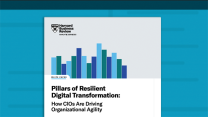The tech world is abuzz with promising, disruptive services that are poised to dramatically change the way businesses operate. From automation and artificial intelligence (AI) to predictive analytics, chief information officers have countless opportunities to improve business processes and help increase the productivity of their workforces.
But the near-term realities of the economy mean that you, as a CIO, must be extremely diligent with your budget, your team’s time, and your organization's needs.
Standing out through successful automation and digital transformation is critical for CIOs right now. We are in a bit of a make-or-break phase where the C-suite is likely putting greater scrutiny on internal digital infrastructure changes or upgrades as many firms seek to reduce costs.
For CIOs, this is an opportunity to reinforce the importance of your role. You can leverage the current market to address some of the biggest challenges facing your organization and maximize your own enterprise value.
Do your goals mesh with mission-critical business strategies?
Now is not the time to automate for the sake of automation. We’re seeing pressure from all sides for businesses to cut costs and improve productivity. Mark Zuckerberg’s recent email to Meta employees highlighted phrases like “flatter is faster” and “leaner is better.”
[ Related read: Automation strategy: 5 questions CIOs should ask. ]
One of the key elements of success for CIOs this year is to clearly demonstrate how your automation and digital transformation strategy aligns with the needs of your business. Because many businesses’ needs have shifted from what was important in previous years, 2023 presents an entirely new playing field. That means CIOs need to take a hard look at the biggest challenges each department faces.
To create a roadmap that aligns with overarching business goals, start by identifying business weaknesses and what is holding back certain departments in your organization. This should include pinpointing processes that are repetitive, time-consuming, have a high likelihood of error, and potentially generate complaints from your constituencies. Additionally, you should be able to identify any of the automation processes you want to implement and be able to explain the “How?” to stakeholders:
- How does it benefit our people?
- How does it benefit our clients and customers?
- How does it benefit our bottom line?
To do this, think of yourself as a consultant to the businesses: identify how to close gaps in productivity and align automation efforts with the goals of each service line. This requires putting aside biases. Your customers are the departments you serve–think about the different needs of marketing, finance, sales, and other groups.
The roadmap and plan for automation cannot stand alone. Both need to be seen as mechanisms that enable leaders and team members to do more with less or reach a new market, launch a new product, reduce costs, or improve the client experience.
Feedback loop and virtuous cycle of automation
One of the biggest hindrances facing CIOs is operating without input from the workforce. This feedback and insight are critical when it comes to automation in 2023. A digital transformation project that is rejected by the workforce is always costly, but when budgets come under scrutiny, you must–more than ever–be able to show success. Success starts with planning.
Now is the time to conduct due diligence around the business. Ask questions such as, “Hey [manager/VP/director], what is stopping you and your team from achieving your goals, saving time, or being more productive? If we could do something faster, better, or more effectively, what would it be?”
Another successful tool is hosting hackathons or brainstorming workshops with diverse members of the organization. Harvesting the creativity and problem-solving skills of the workforce can help you prioritize automation needs and, more importantly, create buy-in.
Emphasizing the right needs of the business shows that you know how to listen and translate feedback into success, which can only help the next digital transformation effort. Workforces are often slow to embrace technological change, so having their buy-in from the start can create a more seamless transition from implementation and training to post-implementation feedback and utilization.
Showcasing ROI
Nothing matters more than the impact your automation or transformation processes have on the three most important aspects of the business: the employees, the clients, and the bottom line. It is imperative in all economic cycles for CIOs to show measurement data and return on investment for major projects, not just during times of prosperity and low interest rates.
The adage “We can’t improve what we don’t measure,” is true. It is also true that we won’t fully understand or appreciate progress without measuring it and that the measurement should be broader than efficiencies gained and dollars saved.
A client once shared with me that automation literally saved their marriage because each annual closing cycle previously required painfully long hours, including working on weekends. This type of “feedback,” although not quantifiable, is incredibly powerful and speaks to the impact of quality automation.
Just as you should reach out to your business divisions to gain insight into their automation needs and desires, follow up on the resulting benefits, which could include measurable data and anecdotal evidence.
The advice highlighted here can help CIOs emphasize their value during challenging times and increase employee engagement in the digital transformation process. It can also help create a comprehensive approach to measuring the impact of automation in an environment where costs are more likely to be questioned and the effectiveness of initiatives more closely evaluated.
[ Learn how leaders are embracing enterprise-wide IT automation: Taking the lead on IT automation. ]








